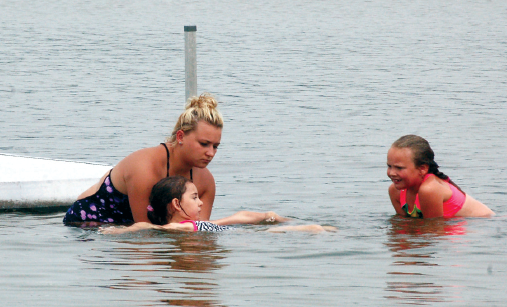Swimming lessons help to not only develop swimming techniques but to build confidence and learn life-saving techniques, said Brooke Huska, the swimming instructor at Annie Laurie Lake.
There were 24 students enrolled for the three one-week sessions that are scheduled to run from July 3 to July 9, July 13 to July 17 and July 20 to July 24.
“I taught the basic components to the Life Saving Society program that included all ages from tots to adults. Swimming is an excellent form of exercise,” she said. “I am a strong believer that everyone should learn how to swim. The life saving aspect is very important.
Swimming is also great exercise and a fun family activity.”
Huska is recent Preeceville graduate who plans to focus on a career in nursing.
She plans to attend the nursing program offered in Yorkton in the fall. She is certified for CPR and AED with the Life Saving Society. This is her first time teaching swimming lessons in a lake setting. She also offers private swimming lessons in her family’s pool.
“Learning to swim or just getting used to the water is a huge asset. Getting children in the water at a young age helps them to build confidence while making them comfortable in the water in any setting. I like to encourage parents to encourage their children to just play games or have some fun in the water.
The more comfortable children become, the more adept they are to learn the proper techniques of swimming and acquire a lifetime skill,” said Huska.
She will be teaching lessons at Lady Lake after Swimming lessons teach valuable life-saving skills lessons in Preeceville conclude.
Huska grew up in the Preeceville area, received her education at the Preeceville School, and was very involved in hockey from an early age. She played female hockey in Kamsack and Springside. She concluded her hockey career at 16 years of age as she concentrates on her education.
As Canada’s leader in drowning prevention, the Lifesaving Society of Canada draws attention to the newly-released global report by the World Health Organization on drowning prevention. This isthe first time that the World Health Organization (WHO) has devoted a report exclusively to drowning prevention, she said. Its significance cannot be over estimated.
The Lifesaving Society supports the development of a co-ordinated national drowning prevention plan that targets communities at risk and the Society is committed to building an inclusive and dynamic coalition to produce and implement it.Its roots trace back to the late 19th century in London, England where it began as the Swimmer’s Life Saving Society. In 1894, Arthur Lewis Cochrane brought to Canada the lifesaving skills he learned in his homeland, and he passed them along to students at Upper Canada College in Toronto.
In June 1896, 18 of his students were the first recipients of the distinguished Bronze Medallion award, the first award created by the Society. Under the patronage of King Edward VII in 1904, the society name changed to The Royal Life Saving Society.
Today, it is simply called the Lifesaving Society. In the 1950s, the Lifesaving Society was the fi rst Canadian organization to adopt mouth-to-mouth rescue breathing as the method of choice over manual methods of artificial respiration. CPR training followed in the 1960s.

.png;w=120;h=80;mode=crop)


